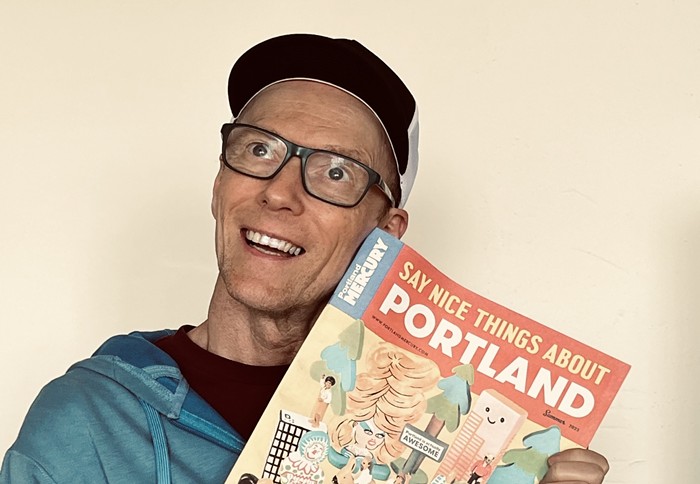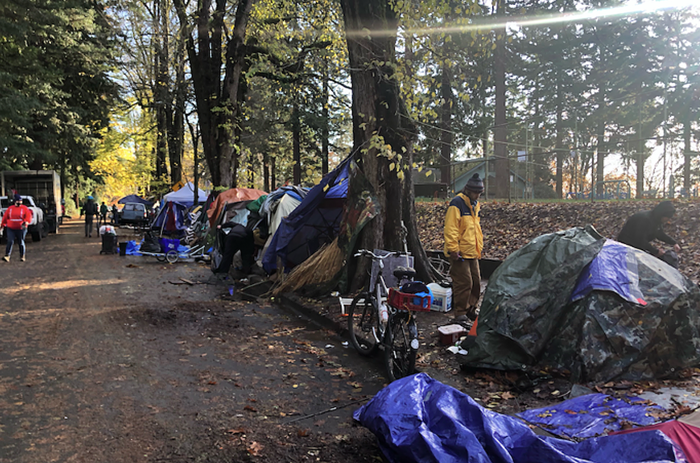LIKE EVERYONE ELSE, you've probably complained about Portland's high rents and property prices. However, there's a reason we're in this situation today—it's because of decisions made decades ago.
It's important to note that what's happening isn't just a Portland phenomenon, though. Throughout the country, cities are changing. The formerly affluent suburbs, once home to wealthy families living on removed estates of vast lawns and McMansions, are filling up with low-income residents. The urban core, once feared as a hotbed of crime and poverty (See: Death Wish, Daredevil, Dirty Harry, and most popular culture from 1975-2000) are now enclaves for the young working class.
"Downtowns used to be places of light manufacturing and other relatively intrusive industries that made it unpleasant to live around," says Alan Ehrenhalt, author of The Great Inversion and the Future of the American City. "Downtown became a symbol for lots of things that didn't work with living a middle-class life. A lot of people who could leave did."
In Portland, that formerly undesirable core is now quite different—an opulent place filled with craft breweries, yoga studios, and very small dogs. The common term for this process is "gentrification," but according to Ehrenhalt, "demographic inversion" is a more accurate phrase, as it speaks not only to money pouring into poorer neighborhoods, but also low-income populations streaming into outlying areas.
In The Great Inversion, Ehrenhalt describes this happening in several different urban areas, but mostly attributes it to broad market-based changes in American manufacturing and demand. According to him, younger populations no longer seek out the suburban experience the way their parents and grandparents did.
In the case of Portland, far more than just market forces and demographic shifts are responsible for this inversion. Starting in the 1970s, a series of deliberate and purposeful policies drove money and affluent populations to the urban core. These policy changes are why Portland is celebrated as a leader in urban planning, and why it has a reputation among planners as being outstanding in the field.
It's also why the rent is too damn high.
Conventional Solutions
Like other American cities in the mid-20th century, Portland had a problem. People were moving from the city to the suburbs.
"I'd say [Portland] had similar problems to other American cities in that it was beginning to feel the impact of outward movement of population," says Carl Abbott, a Portland State University professor of urban studies and author of several books about Portland. "[There was a] suburbanization of population and slow erosion of downtown retail."
Sy Adler, another professor of urban studies at PSU, is quick to emphasize that, although Portland was indeed experiencing a certain degree of urban hollowing, it wasn't happening nearly as much as in other cities.
"For the early part of the post-World War II period, Portland's surrounding economy and the industry presence held up better than what was happening in the Midwest or other East Coast cities," Adler says, mentioning Detroit as an extreme example.
He also cites Portland's relative lack of racial diversity as another factor that shaped the city.
"There is the old racial dimension of this story," Adler says. "Portland was a much less diverse city than its Midwestern or East Coast counterparts, so there was not nearly the same extent of the 'white flight' phenomenon. It was a mix of things."
Nevertheless, part of Portland's self-image and self-mythologizing is based on being a leader in urban planning—and successfully reacting to a crisis of urban hollowing in the mid-20th century. The slogan "We planned, it worked" is often bandied about in reference to Portland's bustling downtown.
We'll return to Portland's much-ballyhooed "renaissance" in a moment—but before the '70s, Portland was known for embracing entirely conventional means of urban "improvement": focusing on cars, and kicking people out of their homes.
The South Auditorium Urban Renewal Project took place around where downtown's Keller Auditorium is today. In the late 1950s, the surrounding area was home to about 2,300 low-income residents, and in a 1959 guest editorial for the Oregon Journal, a homeowner named Elsie Perry wrote: "[We] have been the victims of rumor, propaganda, indecision, threats, and promises.... No one could sell, lease, or trade property. It was unwise to repair or build... by edict of our city, the area has become the slum that the do-good bunch behind urban renewal so heartily desired."
In the end, all 2,300 people were displaced, along with 141 businesses, and today the formerly "blighted" area is now home to office buildings and the Keller Fountain. There were also plans for a stadium.
"A lot of city leaders expected Memorial Coliseum to be built in the urban renewal area," says Abbott.
The urban renewal project was successful (at least in the eyes of planners), but according to Abbott and Adler it was not innovative. It was precisely the kind of strategy other cities were using in response to perceived urban problems.
Portland was also entirely conventional in how it approached transportation issues. "[Another solution] was improving automobile access with the inner freeway loop," says Abbott, referring to I-405 and I-5, which now encircle downtown. "That comes at the end of the '60s and early '70s—but it was in a lot of people's [minds] during the '50s. Pretty standard stuff."

- Ira Keller Fountain, 1995
- HAGAR / CC BY SA
1972
The year 1972 was one of the most important in Portland's history: That was the year the city got the ball rolling on a plan to take money that would've been used to construct the Mount Hood Freeway (which would've been built where SE Clinton is today) and instead use the $500 million as the initial investment on a light rail system.
According to Adler, this was, at the time, an unusual thing for an urban area to do. "Portland was second after Boston in persuading the federal government to move money from highways to transit," he says.
That focus on mass transit was the cornerstone of Portland's 1972 Downtown Plan, which focused on getting economic activity back into the urban core.
"That was [then-Mayor Neil] Goldschmidt's major thing," says Adler. "Instead of highways displacing people, let's boost downtown via transit investment."
The plan sketched out a transit mall, a plan to lure in new retail, and, oddly, covered skyways and arcades along sidewalks that were never constructed. The plan gave Portland an entirely new and updated urban core.
Near downtown, and connected to it by various bus lines, were middle-class neighborhoods populated by single-family homes. Adler describes these mid- to low-density neighborhoods (citing Irvington as a specific example) as Goldschmidt's constituency. He characterizes inner-neighborhood dwellers as being the type of people that Goldschmidt and other planners wanted to serve, and their type of housing was deemed important.
That meant that—with the notable exception of Albina—inner neighborhoods received preservation and investment, especially those featuring single-family housing. The kind of density necessary to meet today's demand for housing was not on anyone's radar. The neighborhoods have stayed static, though demand has not.
"Hawthorne is more commercial than it was back then," says Adler, "but depending on the neighborhood, not an awful lot has changed."
The Boundary
In 1973, Oregon passed land-use legislation decreeing that urban areas must set urban growth boundaries [UGB]. The intent of the legislation was to preserve agricultural and wilderness lands, and also, according to Adler, increase investment inside cities rather than in exurban or suburban areas.
"I think it's very likely the case," he says, "that there's been more inward investment than there would've been otherwise [because of the UGB]." And according to Adler, policymakers knew that the UGB would increase the value of land inside it.
"As people talked about it at the time... yes, the urban growth boundary was intended to increase the price of land inside the line," Adler says.
Today Portland lacks the tract housing found outside cities like Jacksonville or Las Vegas. Unchecked housing speculation didn't happen here (which is good), but it also resulted in a significant lack of readily available, cheap housing.
Currently, market forces aren't supporting affordable housing, and neither is policy. Oregon, unlike other states, has no policy on the books explicitly promoting inclusionary zoning.
"Portland hasn't been able—or willing, early on—to do what many other cities have done and have an inclusionary housing policy," says Adler. "Within urban renewal districts, there has been some bargaining with private investors about... affordable housing units."
This is not an issue Portland can change on its own.
"In the later 1990s, the legislature pre-empted the ability of the city or Metro to do inclusionary housing," says Adler, referring to Oregon's state law banning the practice.

- Thomas Teal
Now
When asked what it would've been like for a middle-class family looking for housing in Portland in the 1970s and 1980s, Abbott and Adler both have similar answers: It was much easier to get a roof over your head than it is now.
"There was a lot of housing available, and at the same time Portland was not growing nearly as fast in the 1950s and '60s—so there wasn't demand [in the '70s]," says Abbott. "The population was growing, but it wasn't booming. There was a more even balance between supply and demand."
Portland today is almost the direct inverse of what it was prior to the early 1970s: People want to live here, houses and apartments are in demand, and there's virtually nothing that could be described as "blight."
"Notice there's no zone of abandonment in Portland," says Abbott. "You go to Houston, and you see a whole sea of parking lots that seems to stretch for miles before there's anything else. Portland has no abandoned zones. There's downtown, there's the Central Eastside, and then there are neighborhoods where people want to live. There's an empty block here and there, but that's not going to last for long."
According to Abbott, that's both a blessing and curse. There are no dead zones, but there are also no cheap zones—at least not within the city itself.
"What's happened in the core area, the South Waterfront, and the Inner Eastside is very much the heritage of what happened in the 1970s," says Abbott, who characterizes Portland (not including a brief recession in the '80s), as being in the midst of a "25-year boom."
Portland was designed and planned to serve a different kind of population and demographic than the one it now attracts. Somehow, this city of single-family homes, light industry, and shipping became cool. Somehow, it attracted a population eager to live in its current limited supply of homes.
When asked how Portland became cool, a fact that led to our housing supply being in such high demand, both Adler and Abbott are happy to speculate—but neither of them give answers nearly as definitive as the ones they offer about Portland's planning history. Abbott has studied and written about this city extensively throughout his career, but to this question, his first reaction is to laugh.
"That I don't know," he says.














